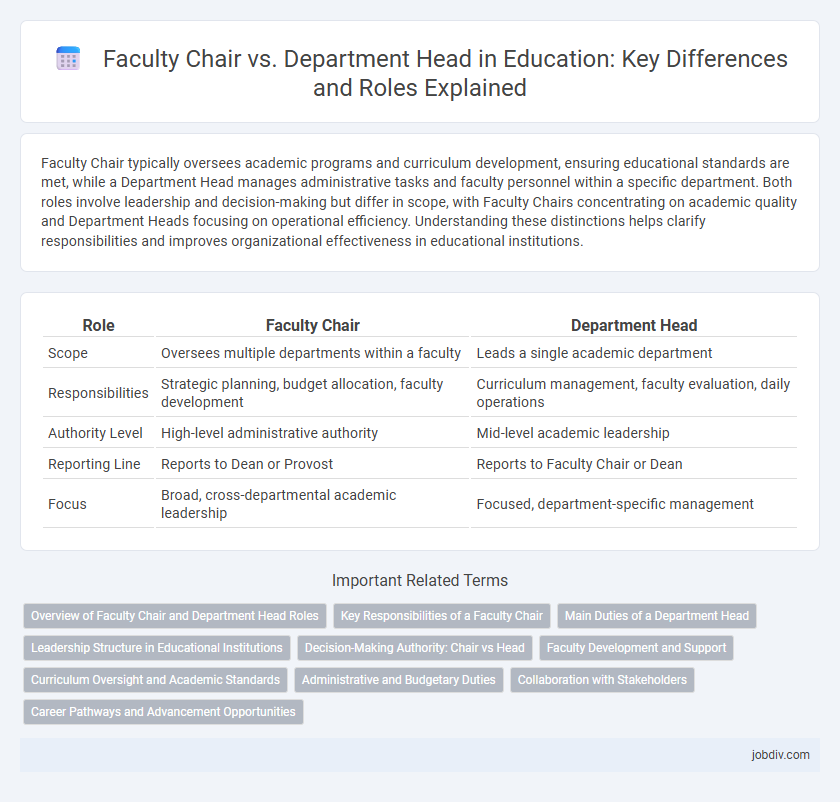Faculty Chair typically oversees academic programs and curriculum development, ensuring educational standards are met, while a Department Head manages administrative tasks and faculty personnel within a specific department. Both roles involve leadership and decision-making but differ in scope, with Faculty Chairs concentrating on academic quality and Department Heads focusing on operational efficiency. Understanding these distinctions helps clarify responsibilities and improves organizational effectiveness in educational institutions.
Table of Comparison
| Role | Faculty Chair | Department Head |
|---|---|---|
| Scope | Oversees multiple departments within a faculty | Leads a single academic department |
| Responsibilities | Strategic planning, budget allocation, faculty development | Curriculum management, faculty evaluation, daily operations |
| Authority Level | High-level administrative authority | Mid-level academic leadership |
| Reporting Line | Reports to Dean or Provost | Reports to Faculty Chair or Dean |
| Focus | Broad, cross-departmental academic leadership | Focused, department-specific management |
Overview of Faculty Chair and Department Head Roles
Faculty Chairs are responsible for overseeing academic programs, guiding faculty development, and ensuring curriculum quality within a faculty, while Department Heads manage administrative tasks, coordinate departmental resources, and facilitate communication between faculty members and higher administration. Both roles demand leadership in academic governance and strategic planning but differ in scope, with Faculty Chairs typically covering broader disciplinary areas and Department Heads focusing on specific departments. Effective collaboration between these positions enhances educational quality and departmental efficiency.
Key Responsibilities of a Faculty Chair
A Faculty Chair primarily oversees academic programs, ensuring curriculum quality and faculty development align with institutional goals. Responsibilities include coordinating faculty meetings, managing budgets, and supporting research initiatives to enhance departmental performance. This role emphasizes strategic leadership, fostering collaboration among faculty members to promote effective teaching and academic excellence.
Main Duties of a Department Head
A Department Head oversees curriculum development, faculty recruitment, and resource management within their academic unit, ensuring alignment with institutional goals. They coordinate departmental meetings, evaluate faculty performance, and handle budget allocations to support program growth. Their role emphasizes operational leadership, whereas a Faculty Chair often focuses more on academic strategy and external representation.
Leadership Structure in Educational Institutions
Faculty Chairs typically oversee academic committees and curriculum development, focusing on collaborative leadership within specific academic programs. Department Heads manage broader administrative responsibilities including budgeting, staffing, and policy enforcement, serving as the primary executive authority in departments. This leadership structure balances academic guidance and operational management to enhance institutional effectiveness in educational settings.
Decision-Making Authority: Chair vs Head
Faculty Chairs typically hold broader decision-making authority over curriculum design, faculty recruitment, and budget allocations within their academic unit. Department Heads focus on operational management, including scheduling classes, managing departmental resources, and overseeing day-to-day faculty activities. While Chairs set strategic direction aligned with institutional goals, Heads ensure implementation and compliance at the departmental level.
Faculty Development and Support
Faculty Chairs primarily focus on strategic faculty development and fostering professional growth through workshops, mentorship programs, and research support. Department Heads manage daily administrative tasks while also facilitating faculty support by coordinating resources, addressing individual needs, and ensuring alignment with academic goals. Both roles are critical for creating a supportive environment that promotes continuous faculty improvement and academic excellence.
Curriculum Oversight and Academic Standards
The Faculty Chair primarily oversees curriculum development and ensures alignment with institutional academic standards, coordinating cross-departmental input to maintain program quality. The Department Head manages day-to-day academic operations within a specific department, implementing curriculum decisions and monitoring faculty adherence to established standards. Both roles collaborate to uphold rigorous academic criteria and continuous curriculum improvement.
Administrative and Budgetary Duties
Faculty Chairs primarily oversee academic leadership, curriculum development, and faculty evaluations, while Department Heads manage departmental administration and budgeting. Department Heads are often responsible for allocating financial resources, preparing budgets, and ensuring compliance with institutional policies. Both roles require collaboration but differ significantly in administrative and budgetary scope within educational institutions.
Collaboration with Stakeholders
Faculty Chairs coordinate curriculum development and research initiatives by fostering collaboration among professors, students, and external academic partners. Department Heads manage day-to-day operations and serve as primary liaisons with university administration, industry representatives, and accreditation bodies. Both roles require strong communication skills to align institutional goals with stakeholder expectations and promote academic excellence.
Career Pathways and Advancement Opportunities
Faculty Chairs typically balance administrative duties with teaching and research, positioning themselves for senior academic leadership roles such as Dean or Provost. Department Heads often focus more on operational management and faculty coordination, which can lead to advancement in university administration or specialized academic leadership positions. Both roles enhance strategic decision-making skills, but Faculty Chairs usually have broader influence on curriculum development and policy, supporting diverse career pathways in academia.
Faculty Chair vs Department Head Infographic

 jobdiv.com
jobdiv.com